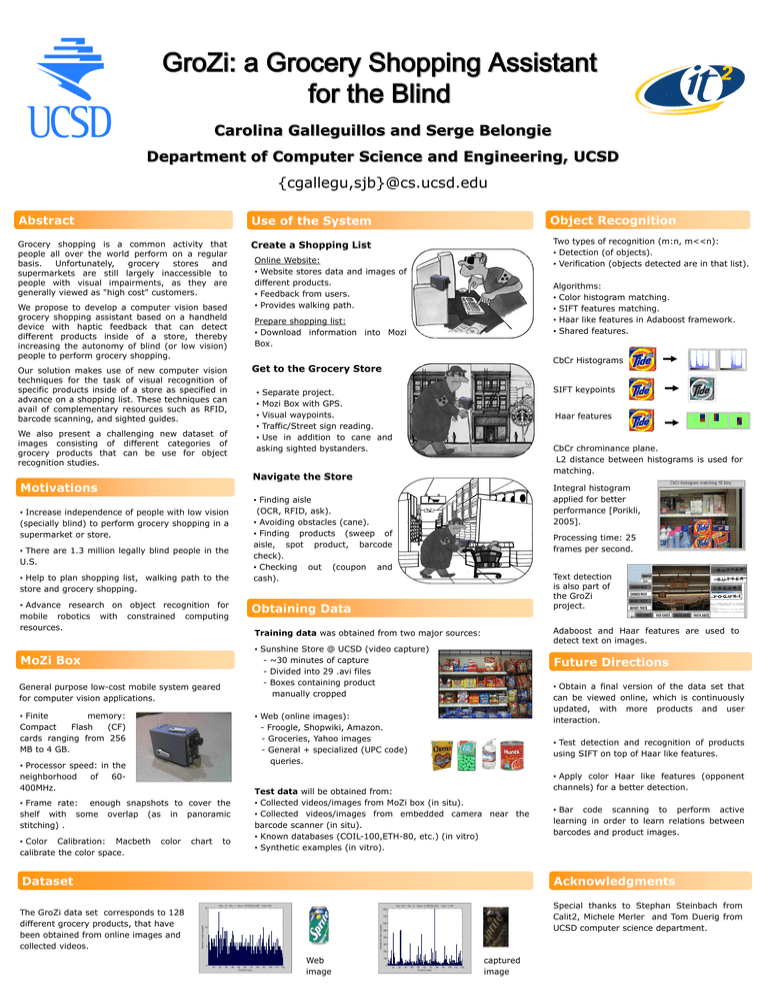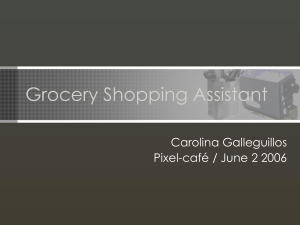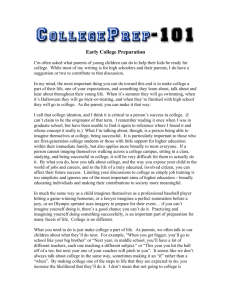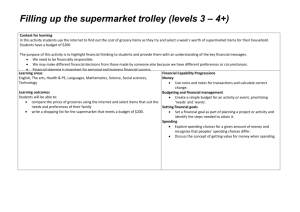ppt - GroZi
advertisement

GroZi: a Grocery Shopping Assistant
for the Blind
Carolina Galleguillos and Serge Belongie
Department of Computer Science and Engineering, UCSD
{cgallegu,sjb}@cs.ucsd.edu
Abstract
Use of the System
Grocery shopping is a common activity that
people all over the world perform on a regular
basis.
Unfortunately,
grocery
stores
and
supermarkets are still largely inaccessible to
people with visual impairments, as they are
generally viewed as "high cost" customers.
Create a Shopping List
We propose to develop a computer vision based
grocery shopping assistant based on a handheld
device with haptic feedback that can detect
different products inside of a store, thereby
increasing the autonomy of blind (or low vision)
people to perform grocery shopping.
Our solution makes use of new computer vision
techniques for the task of visual recognition of
specific products inside of a store as specified in
advance on a shopping list. These techniques can
avail of complementary resources such as RFID,
barcode scanning, and sighted guides.
We also present a challenging new dataset of
images consisting of different categories of
grocery products that can be use for object
recognition studies.
Two types of recognition (m:n, m<<n):
• Detection (of objects).
• Verification (objects detected are in that list).
Online Website:
• Website stores data and images of
different products.
• Feedback from users.
• Provides walking path.
Algorithms:
• Color histogram matching.
• SIFT features matching.
• Haar like features in Adaboost framework.
• Shared features.
Prepare shopping list:
• Download information into Mozi
Box.
CbCr Histograms
Get to the Grocery Store
SIFT keypoints
• Separate project.
• Mozi Box with GPS.
• Visual waypoints.
• Traffic/Street sign reading.
• Use in addition to cane and
asking sighted bystanders.
Haar features
CbCr chrominance plane.
L2 distance between histograms is used for
matching.
Navigate the Store
Motivations
• Increase independence of people with low vision
(specially blind) to perform grocery shopping in a
supermarket or store.
• There are 1.3 million legally blind people in the
U.S.
• Help to plan shopping list, walking path to the
store and grocery shopping.
• Advance research on object recognition for
mobile robotics with constrained computing
resources.
Integral histogram
applied for better
performance [Porikli,
2005].
• Finding aisle
(OCR, RFID, ask).
• Avoiding obstacles (cane).
• Finding products (sweep of
aisle, spot product, barcode
check).
• Checking out (coupon and
cash).
Processing time: 25
frames per second.
Text detection
is also part of
the GroZi
project.
Obtaining Data
Adaboost and Haar features are used to
detect text on images.
Training data was obtained from two major sources:
• Sunshine Store @ UCSD (video capture)
- ~30 minutes of capture
- Divided into 29 .avi files
- Boxes containing product
manually cropped
MoZi Box
General purpose low-cost mobile system geared
for computer vision applications.
• Finite
memory:
Compact
Flash
(CF)
cards ranging from 256
MB to 4 GB.
Future Directions
• Obtain a final version of the data set that
can be viewed online, which is continuously
updated, with more products and user
interaction.
• Web (online images):
- Froogle, Shopwiki, Amazon.
- Groceries, Yahoo images
- General + specialized (UPC code)
queries.
• Processor speed: in the
neighborhood
of
60400MHz.
• Frame rate: enough snapshots to cover the
shelf with some overlap (as in panoramic
stitching) .
• Color Calibration: Macbeth
calibrate the color space.
Object Recognition
color
chart
to
• Test detection and recognition of products
using SIFT on top of Haar like features.
Test data will be obtained from:
• Collected videos/images from MoZi box (in situ).
• Collected videos/images from embedded camera near the
barcode scanner (in situ).
• Known databases (COIL-100,ETH-80, etc.) (in vitro)
• Synthetic examples (in vitro).
Dataset
• Apply color Haar like features (opponent
channels) for a better detection.
• Bar code scanning to perform active
learning in order to learn relations between
barcodes and product images.
Acknowledgments
Special thanks to Stephan Steinbach from
Calit2, Michele Merler and Tom Duerig from
UCSD computer science department.
The GroZi data set corresponds to 128
different grocery products, that have
been obtained from online images and
collected videos.
Web
image
captured
image





